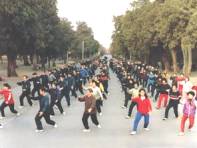|
|
|
PHYSICAL
CULTURE & SPORTS
|
|
Popular
Sports
China??s popular sports have developed
rapidly in the 50 years since the founding of the People??s Republic.
During the early period of New China, people just did aerobic exercises
to radio music during break times, and took part in the spring and
autumn sports meets held each year. As society progressed and the
economy developed, recreational sports started to permeate all levels
of society. Today, about 300 million Chinese take part in sports
activities regularly. In 1951, the All-China Federation
of Sports popularized the first set of exercises to radiomusic, and later on exercises
for adults, young people and children were worked out. In1954, the
|

Taijiquan
boxing enthusiasts doing early
morning exercises.
??
|
|
Chinese
government issued a notice stipulating that
workers and staff of government offices and other organizations
have a ten-minute break in the mornings and afternoons to do exercises
or engage in other sports. In the same years the state also worked
out a sports system to increase labor and defense capabilities,
and it was carried out throughout the country. It was changed into
the Athletic Fitness Standard for young people in the 1960s and
then into State Athletic Fitness Standard in the 1970s. In the past
50 years, about one billion people have met the state standard.
In more than 20 years since the
reform and opening to the outside world started, sports activities
have been rich in variety, in the wake of the development of the
national economy and improvement of the general standard of living.
More and more people consider regular sports activities to be part
of their daily lives in both rural and urban areas.
The first New Long March Sports
Meeting for the Aged was held in Beijing in 1978. The Chinese Association
of Sports for the Aged was founded in April 1983. Then different
mass sports associations and organizations were founded, such as
the Angling Association, Kite Association and Dragon Boat Association.
The popularity of sports activities in China has fostered many world-class
athletes. Among the 94 medals captured in the 1988 Seoul Olympic
Games, 26 were won by athletes from China??s rural areas.
On New Year Day in 1995, the Chinese
government put forward the Whole-People Health-Building Plan, with
the aim of improving the people??s physiques and health. This plan
is named the ??One-Two-One Project,?? whereby everyone should take
part in at least one sports activity every day, learn at least two
health-building methods and take one physical examination once a
year. The Physical Health Law of the People??s Republic of China
was adopted by the Standing Committee of NPC on August 29, 1995.
It was the first time for the state to enshrine the principle of
??promoting physical culture and building up the people??s health??
in law.
Juan Antonio Samaranch,
chairman of the International Olympic Committee, proposed that China
should hold a mass bicycle contest in 100 cities, and in 1995 such
a contest was held in China participated in by more than one million
people from 107 cities, which was considered an unprecedented event
in the world by the representative of Samaranch. In 1998 taijiquan
was performed in Tiananmen Square in Beijing by 10,000 taijiquan enthusiasts
from both China and abroad. In recent years, some new sports, such
as rock climbing, horse racing, bungee jumping, bowling, skateboard,
woman??s boxing, taekwondo and golf are becoming popular among Chinese
people, especially young urban people. Sports grounds and gymnasiums
have never been so busy as at present. For example, swimming pools
in Beijing open from morning till night, and are always busy, and
the number of fitness centers has been increasing day by day. There
are also many roller-skating rinks in Beijing. A lot of people also
play table tennis and tennis. According to investigations of some
Chinese cities, the annual increase rate of the number of people participating
in sports activities is two percent. |
|



